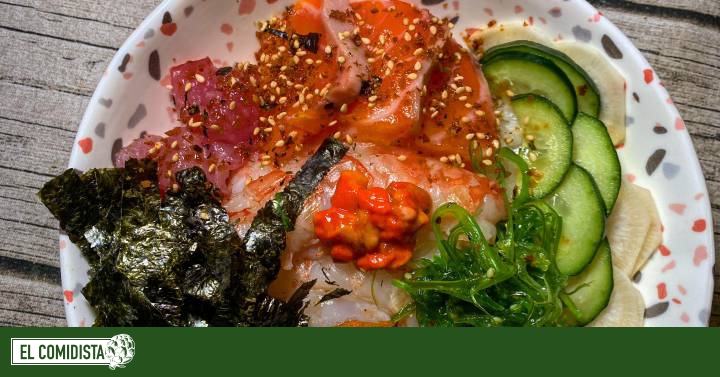The pantries are always on duty.
No matter how abandoned we have left them to their fate, they do not give up their efforts to offer us an old can of preserves, a
brick
of vegetable broth with a just expiration date and a dozen condiments and spices that we have collected over the years. in a usually overly optimistic 'just in case' (as if they had nothing else to do).
We've gone from ground cinnamon, dried oregano, and - hopefully - ground cumin, to bringing together ten different varieties of peppers, eight of salts, and five of unusual seasonings that sometimes languish on the shelf, even with their seal intact. .
They are awake and we still have not discovered what that reddish mixture that we buy just because we were amused by its name is made of.
This is what probably happened to us with the furikake.
Furi… what? Fu-ri-ka-ke
It is a condiment made from algae, sesame and dehydrated protein, usually fish -although vegetarian versions can also be found- from Japan, which jumps between sweet and salty and provides an extra umami there for where it happens;
traditionally, a bowl of steamed white rice or an onigiri.
One of its great benefits, in addition to the hit of flavor, is its crunchy texture capable of making mouth-to-mouth even rice with more water in the lungs.
See this post on Instagram
A post shared by Jessica (@foodbyjessica)
You can find it over a poké in any of the gazillion restaurants that sell it in your neighborhood, on toast with avocado and egg in the last temple of
brunch
or wrapping a simple uramaki in a Japanese bar. There are those who spread it on the popcorn and get so hot, they even say that during the confinement, in full despair, someone served it on a piece of txistorra and called it 'txorikake' (and it was not the first).
Roger Ortuño from the Comer Japanese website, author of the Japanese gastronomy dictionary Oishii, explains that “'furi' means to rain, and 'kake' to pour something, with which furikake means to sprinkle”. So, according to this author, “etymologically it is any mixture of seasonings that are sprinkled on a plate”. How the hot pepper based dressing ichimi? "Yes". And the shichimi, with chili, citrus, seeds and more? “Yes, and the
yukari
and the
konasanshō
. In fact, I use the expression to add something a lot as a furikake ”. Furikakear? Not yet, but this seasoning is called to be a verb.
Thus, we find dozens of variants, such as
green or red
shiso
-perilla-, egg yolk, dried bonito or mackerel flakes,
natto
-fermented soybeans-, with nori, kombu or wakame seaweed, with green tea or even a version with kimchi, among others.
The only condition, as the Japanese chef Masao Kikuchi, introducer of sushi in Spain and teacher of teachers, confirms from his 85 years -many of them of experience- "is that all the ingredients are dehydrated and dry."
From what is necessary to what is accessory
Everything indicates that it was a pharmacist, Suekichi Yoshimaru, the creator of this seasoning called to improve the calcium levels of part of the Japanese population who were not friends with fish. He crushed their spines and disguised them between seeds and seaweed, a kind of 'I crush the cod in the béchamel of the croquettes so you can eat fish', but in the Japanese style, which is always more classy.
Ortuño brings us to one of the first references on furikake on the web, which is precisely from the Gohan No Tomo brand, which means “the friend of rice”.
There is Yoshimaru in black and white with all the face of having invented the furikake.
Master Kikuchi accepts that theory as valid with the help of the Rocío Tapas y Sushi team, that now mythical Japanese tavern whose kitchen has been the last lucky one to see him work.
He is pragmatic: “It can be used wherever it looks good, although it should not be abused to preserve the flavor and aroma of rice.
A well-cooked top quality rice does not need furikake ”.
Itamae-san's
word
.
See this post on Instagram
A post shared by Food Technique Berlin (@foodtechniqueberlin)
Although it was traditionally thought to be used on white rice, there are chefs like David Chang who love it "for its different textures and all that crazy flavors" and spread it on cured fish, grilled peppers or a sandwich beef and cheese; without regard. Alfonso D. Martín, a young chef and foodie collaborator who always has a spoon in the East, loves fried foods and “especially on karaage chicken with lemon zest”.
What was necessary at the beginning of the 20th century today has become an accessory, but tenacious as we are in chaining satisfactions, it never hurts to add a little sugar to the pill to make it happen better. Alfonso is packed: “We can also throw our stuff and make some puritan go crazy: imagine a Russian salad with prawns and furikake or some pickled anchovies or fried squid with a furikake aioli. It's fetén! ”.
He strongly recommends that we make the preparation ourselves at home and that we do not cook it so that "it does not lose the charm of its textures or its intensity due to cooking" although if the furikake is commercial and has been in the package for an eternity, " a very rapid heat stroke does not hurt at all to reactivate the aromas that may remain ”.
Seasoning is an art, but one of those that can be handled.
Recipe
You can find different furikakes from traditional Japanese houses such as Mishima or Tanaka online at Japonshop, in Tokyo-ya or one of the increasingly large Asian corner markets at a price of between three and four euros for 30 grams. The Dutch brand Terrasana imports and distributes in Europe a vegan furikake made from black and white sesame seeds, algae and organic sea salt that is easy to find in organic food stores and supermarkets (8.85 euros per 100 grams).
However, since everything made at home tastes better (sometimes), we have asked Luis Alcázar from Madrid, father and mother of the spice shop and more Black Pepper & Co, to share with us the recipe for what would be his furikake perfect: “It has spicy, umami, different textures, citric and acid touches, smoked and with a sea flavor”.
For him the invention of furikake, more than for health, was due to a matter of boredom: "All day eating rice, they would have to do something to make it funny!"
The furikake that Luis Alcázar prepares in his store.
BLACK PEPPER & CO
For 100 grams of furikake, mix
15 g fleur de sel
15 g dehydrated and crushed nori seaweed
35 g of sesame seeds with umeboshi
10 g of takobushi (smoked octopus in shavings)
5 g of ground sansho pepper
20 g of gochugaru chili pepper (Korean chili) in flakes
From here, where to sprinkle it is up to you.








